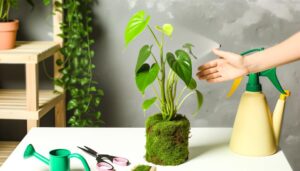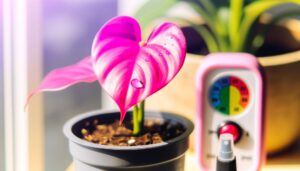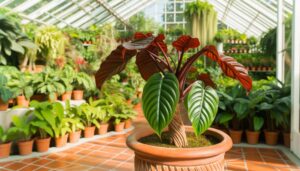Red Anderson Philodendron Care
The Red Anderson Philodendron, originating from South America's rainforests, thrives under bright, indirect light with temperatures between 65-78°F. It requires moderate humidity (40-60%), water when the soil's top inch dries out, and a well-draining soil blend rich in nutrients.
Overwatering can cause root rot, signaled by yellowing leaves. Fertilize monthly using a balanced mixture with a 20-20-20 N-P-K ratio.
Timely pruning in spring or early summer along with disease vigilance ensure a healthy plant. Propagate through stem cuttings with multiple leaf nodes.
Becoming more knowledgeable about best care can guarantee this tropical beauty flourishes.
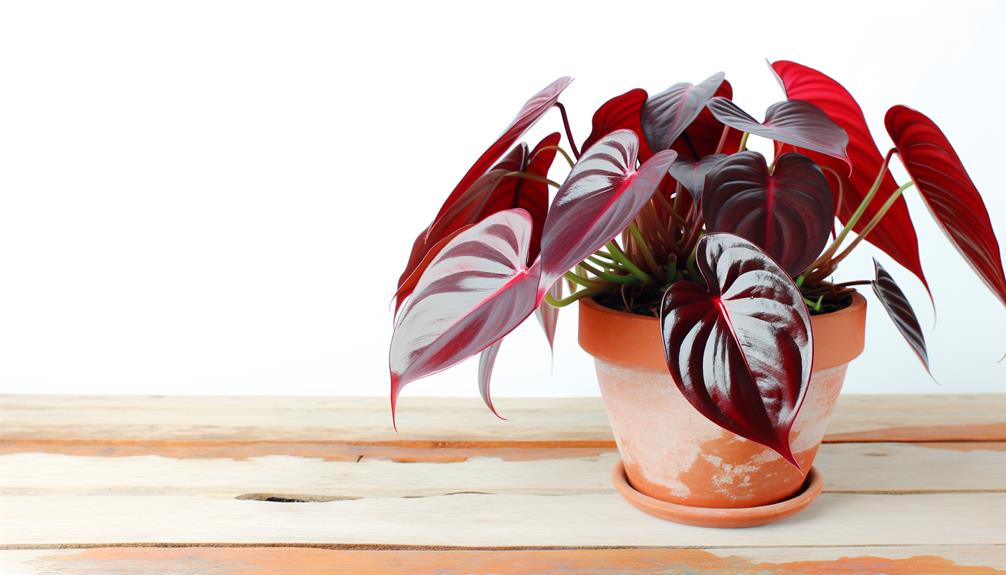
Key Takeaways
- Red Anderson Philodendron thrives in bright, indirect light with temperatures between 65-78°F and humidity levels of 40-60%.
- Water the plant only once the top inch of soil has dried out, using room temperature water.
- It prefers well-draining, nutrient-rich potting mix and a slightly acidic to neutral pH.
- Regular pruning, maintenance, and fertilization are essential for the plant's health and growth.
- Be vigilant in spotting common issues like yellow leaves or pests and take timely corrective action.
Understanding the Red Anderson Philodendron
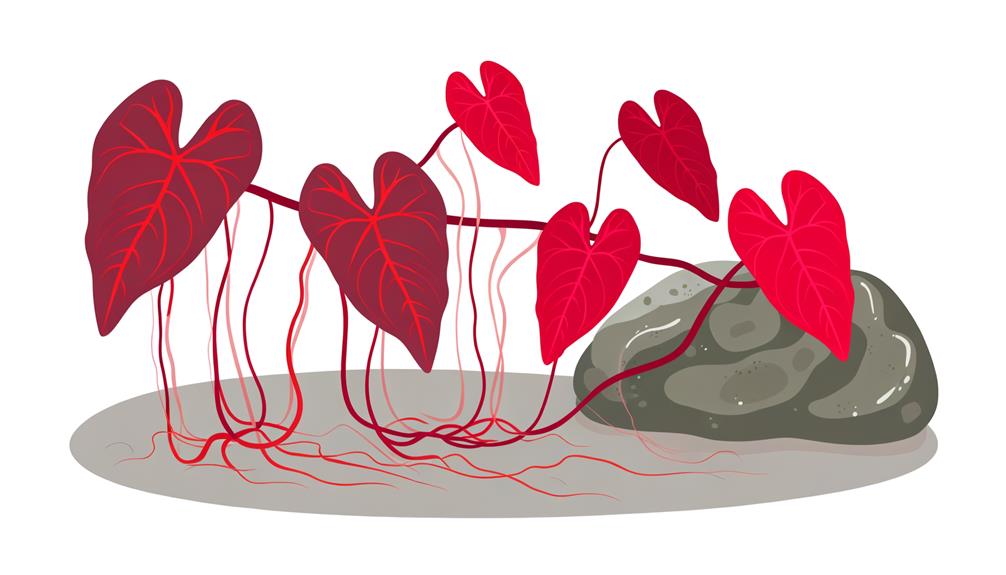
The Red Anderson Philodendron, an exotic and vibrant houseplant, requires an in-depth exploration into its unique characteristics and care requirements to truly appreciate its beauty and maintain its healthy growth. Hailing from the tropical rainforests of South America, this plant is known for its striking red leaves which mature into a deep green color.
Its large, heart-shaped leaves are a hallmark feature, making it a visually enchanting addition to any interior environment. The Red Anderson Philodendron is an epiphytic plant, meaning it grows on other trees or plants for support, but not for nutrients. Hence, it requires well-drained soil and moderate humidity levels.
Regular fertilization is also essential to keep this plant healthy, which can be accomplished with a balanced, water-soluble fertilizer.
Ideal Lighting Conditions for Growth
The Red Anderson Philodendron thrives under specific lighting conditions, making it essential to understand its light requirements for best growth.
This involves striking a delicate balance to prevent light-related damage, ensuring the plant receives enough light without being exposed to harsh, direct sunlight.
Let's discuss the nature of these ideal lighting conditions and the steps you can take to maintain them.
Understanding Light Requirements
Bathing in bright, indirect light, the Red Anderson Philodendron thrives best, showcasing vibrant growth and robust health. Ideally, the plant prefers being placed near a window with filtered sunlight, avoiding harsh midday rays that can lead to leaf scorching.
The philodendron's health is largely dictated by its lighting conditions; insufficient light can lead to slow growth and lackluster foliage, while excessive direct light can cause adverse effects.
If indoor lighting conditions aren't ideal, consider utilizing grow lights. These devices simulate the full spectrum of light and can be adjusted to provide the best intensity. With proper lighting, this tropical beauty will flourish, contributing to a serene and uplifting environment for all to enjoy.
Understanding these light requirements is paramount to successful Red Anderson Philodendron care.
Preventing Light-Related Damage
While understanding the lighting requirements is an important aspect of Red Anderson Philodendron care, it is equally crucial to take measures that prevent any light-related damage to this tropical beauty.
To secure your plant thrives without suffering from light stress, it should be shielded from direct sunlight, which can scorch its leaves. Instead, place your Philodendron in a location that receives bright, indirect light. This could be near a north-facing window, or a few feet away from a south or west-facing window.
To further safeguard your plant, consider using blinds or sheer curtains to diffuse the light. Remember, consistency in light exposure is key to maintaining a healthy Red Anderson Philodendron, so avoid abrupt changes in lighting conditions.
Watering Your Red Anderson Philodendron
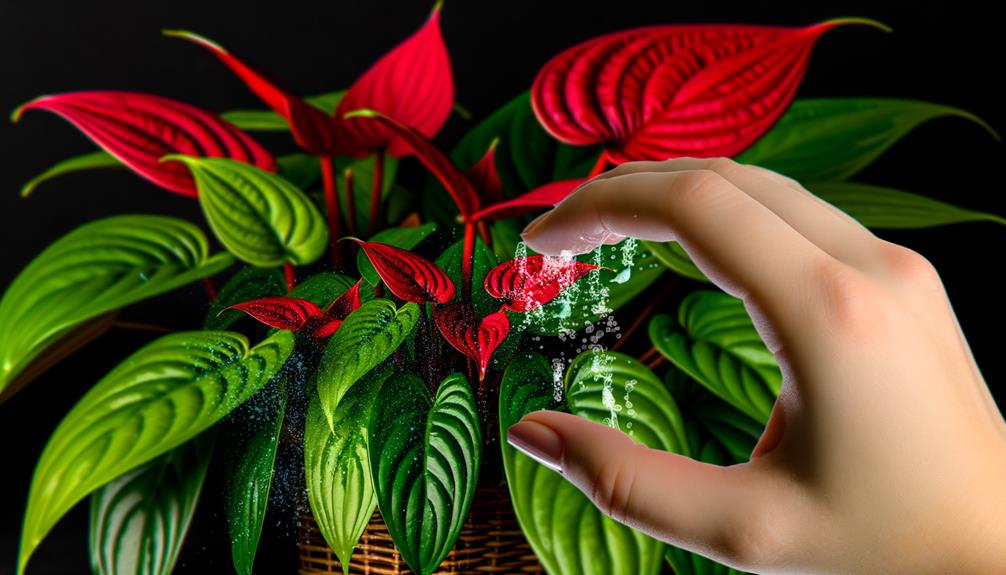
Proper hydration is a critical aspect of Red Anderson Philodendron care, requiring a balanced approach to guarantee peak plant health. Watering should be performed once the top inch of soil has dried out, typically once a week.
Overwatering can lead to root rot, a destructive condition that can severely damage this plant. Use room temperature water and water your plant thoroughly until water drains out of the bottom of the planter. If the leaves show signs of yellowing, it could indicate excess water.
On the other hand, brown leaf tips may suggest under-watering. Always be attentive to these signs and adjust your watering routine accordingly. Remember, a consistent watering schedule is key to maintaining a healthy Red Anderson Philodendron.
Optimal Temperature and Humidity
The Red Anderson Philodendron thrives best when provided with the right temperature and humidity conditions.
A thorough understanding of its ideal temperature ranges and specific humidity requirements is key to promoting healthy growth and importance.
Let's explore these critical aspects in detail.
Ideal Temperature Ranges
Cultivating a robust Red Anderson Philodendron requires maintaining a prime temperature range of 65-78°F (18-26°C) and a humidity level between 40-60%, fostering a tropical haven for this exotic plant.
To ensure these conditions, regular checks using a thermometer and hygrometer are advised. If you reside in a region with a colder climate, consider a heated greenhouse or indoor cultivation using a space heater and proper insulation.
Avoid temperature fluctuations as this can stress the plant, leading to leaf drop or stunted growth. In periods of intense heat, shielding the plant from direct sunlight can prevent scorching.
Balancing these temperature requirements with proper watering, light, and nutrition, you can provide ideal conditions for your Red Anderson Philodendron to flourish.
Humidity Requirements
In harmony with the ideal temperature, the Red Anderson Philodendron thrives in a humid environment, specifically within a range of 40-60%. Adequate humidity is essential to promoting luscious growth and preventing leaf curling or yellowing.
- Maintain Consistent Humidity:
Use a digital hygrometer to monitor humidity levels. These devices are accurate and easy to use, ensuring your plant's environment is kept within the best range.
- Misting:
Regularly misting the plant with water can help maintain humidity. However, avoid excessive misting as it may lead to fungal diseases.
- Humidity Trays or Humidifiers:
Placing the plant on a tray of pebbles and water, or using a room humidifier can effectively increase humidity.
Proper Soil Selection
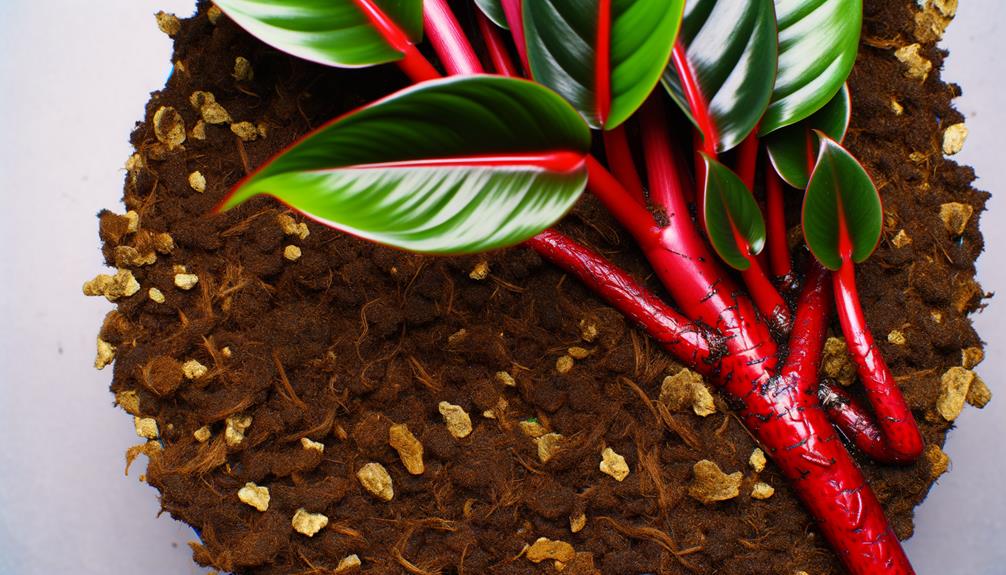
Selecting the right soil plays an important role in the healthy growth and development of your Red Anderson Philodendron. This tropical plant thrives in a well-draining, nutrient-rich potting mix.
A blend of peat moss, perlite, and coarse sand is recommended to ensure best growth. The peat moss retains moisture and nutrients, providing a lush environment for your plant. Perlite enhances aeration, promoting root health and preventing waterlogging. Coarse sand further improves drainage, an essential factor for philodendrons, which are prone to root rot in soggy conditions.
Conduct a basic soil test to verify pH levels; a slightly acidic to neutral pH (6.0-7.0) is ideal for your Red Anderson. Remember, the right soil is a fundamental step in successful philodendron care.
Fertilizer Recommendations
Building on the significance of soil selection, proper fertilization is another key component to ensuring robust growth and vibrant foliage in your Red Anderson Philodendron.
To maintain a thriving plant, consider these three pivotal fertilizer recommendations:
- Balanced Fertilizer: Opt for a balanced, water-soluble fertilizer with equal ratios of nitrogen, phosphorus, and potassium (N-P-K). The numbers 20-20-20 are ideal.
- Frequency: Fertilize every month during the growing season (spring and summer). In fall and winter, reduce to once every 6-8 weeks.
- Application: Dilute the fertilizer to half strength to prevent root burn. Apply the solution to the soil, ensuring it is evenly distributed.
Pruning and Maintenance Tips

To guarantee the best health and aesthetic appeal of your Red Anderson Philodendron, regular and effective pruning is necessary.
In addition, a consistent maintenance regimen is essential for the plant's overall well-being.
We will now explore specific pruning techniques, regular upkeep practices, and how to handle common issues that may arise.
Pruning Techniques for Philodendrons
Understanding the right pruning techniques is essential for maintaining the health and aesthetics of your Red Anderson Philodendron.
Here are three key steps to follow:
- Identify the Right Time: Pruning is best done in spring or early summer when the plant is growing actively. Avoid pruning in winter as it may stress the plant.
- Use Clean Tools: Always use sharp, sterilized pruning shears to avoid infecting the plant with diseases.
- Prune Correctly: Cut just above a leaf node, the point where a leaf or branch is attached to the plant. This encourages new growth and keeps your plant healthy and bushy.
Regular Maintenance Practices
Incorporating regular maintenance practices, such as appropriate watering, ideal positioning for light exposure, and timely fertilization, alongside prudent pruning, can greatly enhance the health and aesthetic appeal of your Red Anderson Philodendron.
It's important to water this plant adequately but not excessively, as overwatering can lead to root rot. Position your philodendron in a location with indirect sunlight, as direct sunlight can scorch its leaves.
Regular fertilization, preferably every 6 weeks during the growing season, is also beneficial. Pruning is an equally significant aspect of maintenance. Regularly remove any yellow, brown, or damaged leaves to allow new growth and keep the plant looking its best.
These practices collectively ensure your philodendron's longevity and flourishing growth.
Dealing With Common Issues
Managing the common issues that may arise during the care of your Red Anderson Philodendron requires a keen eye, a gentle touch, and a thorough understanding of specific pruning and maintenance techniques.
- Pruning: Remove dead or yellowing leaves to maintain the plant's health and aesthetics. Use a clean, sharp tool to make smooth cuts close to the stem.
- Watering: Overwatering is a common issue. Wait until the top inch of soil is dry before watering again. This plant prefers consistency rather than excess.
- Pest Control: Regularly inspect for pests such as aphids or spider mites. If detected, use a gentle insecticidal soap or neem oil.
Addressing Common Diseases
One must remain vigilant to maintain the health of your Red Anderson Philodendron, as it may fall victim to several common diseases, such as root rot and leaf spot.
Root rot often occurs due to overwatering and poor drainage, leading to a soggy environment conducive to fungus growth. To combat this, make sure your plant's potting mix is well-draining and avoid overwatering.
Leaf spot, on the other hand, is characterized by dark, water-soaked spots on leaves. It can be caused by various fungi or bacteria. To control this disease, remove infected leaves and avoid overhead watering to keep foliage dry. Also, maintain good air circulation around the plant to prevent disease spread.
Regular inspection and timely action can keep your plant disease-free.
Repotting Your Red Anderson Philodendron
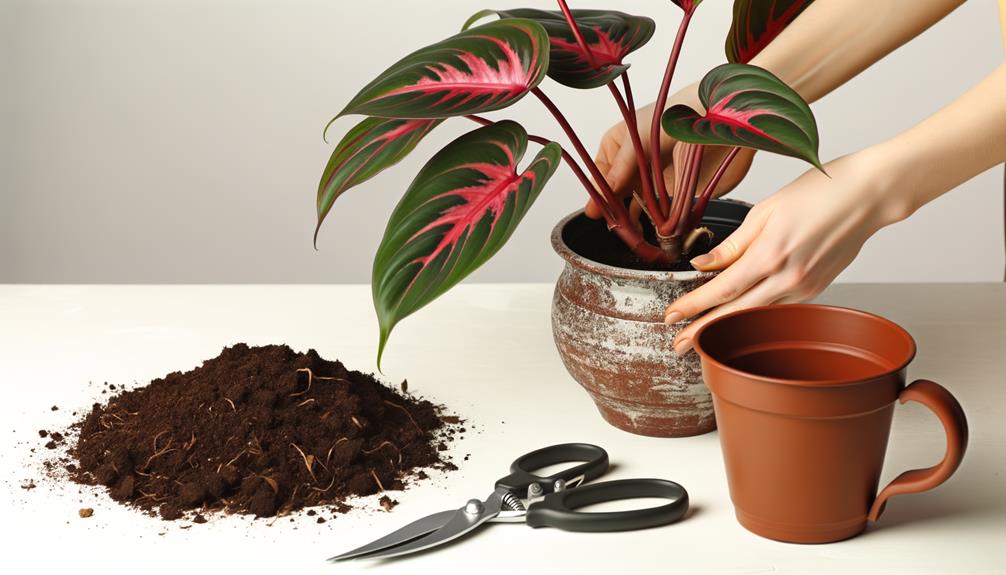
While maintaining the health of your Red Anderson Philodendron through disease prevention is important, another key aspect of its care involves the process of repotting. This process is necessary to provide the plant with fresh soil and ample space to grow.
For successful repotting, you should follow these steps:
- First, choose a pot that is two inches larger in diameter than the current pot. This guarantees the plant has space to grow without becoming root-bound.
- Next, prepare a soil mix that retains moisture but also drains well. A combination of peat, perlite, and bark is highly recommended.
- Finally, carefully remove the plant from its current pot, ensuring minimal root disturbance. Place it in the new pot, and gently surround it with the fresh soil mix.
Propagation of Red Anderson Philodendron
How does one propagate the Red Anderson Philodendron effectively?
The process begins with the careful selection of a healthy stem cutting, ideally with several leaf nodes.
This cutting should be taken during the growing season, spring or early summer, to maximize success.
Dip the cut end into rooting hormone to encourage root development and plant it into a pot filled with a well-draining soil mix.
Keep the environment humid and warm, but make sure the cutting is out of direct sunlight.
Regularly monitor the moisture level of the soil, keeping it consistently damp but not waterlogged.
With patience and careful attention, your cutting should begin to develop roots and sprout new leaves, marking the successful propagation of your Red Anderson Philodendron.
Troubleshooting Common Issues
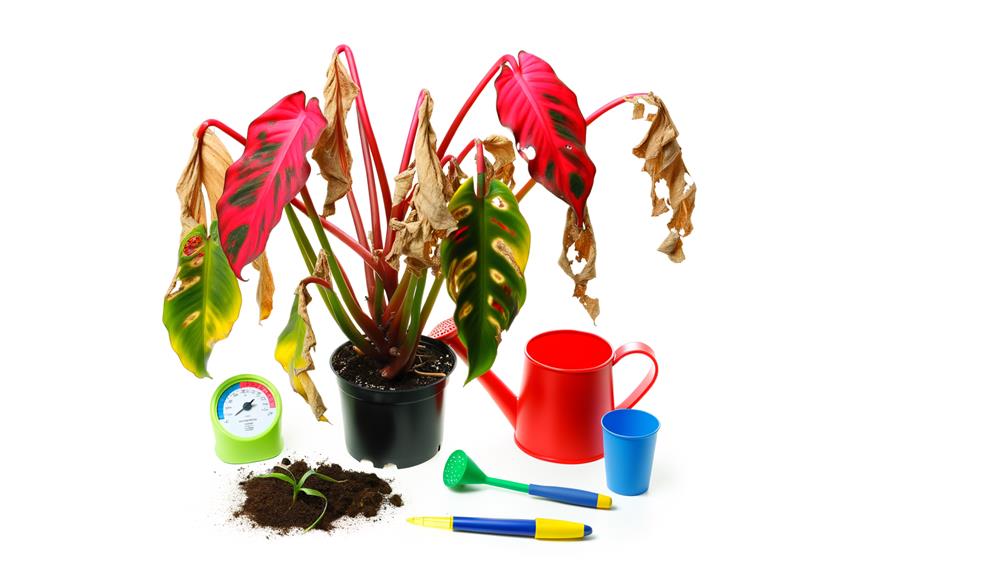
Despite the resilience of the Red Anderson Philodendron, certain common issues may arise, requiring careful troubleshooting to guarantee the plant's health and essentiality.
- Yellow Leaves: This is often due to overwatering. Confirm the plant isn't sitting in water and the soil is well-draining.
- Brown Leaf Tips: This issue is commonly associated with low humidity. Regularly mist your Philodendron or place it on a water-filled pebble tray.
- Slow Growth: This could be due to inadequate light or nutrients. Position your plant in bright, indirect light and feed it with a balanced liquid fertilizer during the growing season.
Conclusion
To sum up, the majestic Red Anderson Philodendron, with its vibrant foliage, can adorn any space with sheer elegance. Its care demands precision, understanding, and commitment.
Remember, the correct balance of light, water, temperature, humidity, and soil can result in a thriving plant. Regular inspections for diseases, timely repotting, and propagation guarantee a healthy life cycle.
The joy of nurturing this plant to its full glory is indeed a rewarding experience.


